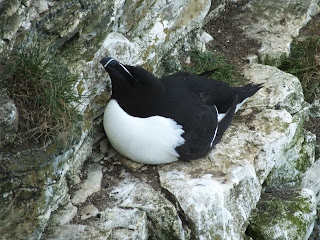On Sunday the 7th of June, I visited Bempton Cliffs again. This is a hugely popular place for birdwatchers, unsurprisingly, as during the summer months the cliffs are packed with thousands of seabirds.
 |
| Gannet |
 |
| Gannet |
The most obvious, and in my opinion the most impressive of these, is the gannet,
Morus bassanus. With a two metre wingspan, these huge birds are the first ones my eye is drawn to as they soar below the cliff face. Their song, if you can call it that, is a series of quick, quite harsh, monotonous notes strung together; a constant soundtrack to my walk along the clifftop.
 |
| Kittiwake |
 |
| Kittiwake |
The next bird I'm aware of, by hearing it at first rather than seeing it, is the rather delicate-looking kittiwake,
Rissa tridactyla. Its gentle features give you the idea that this is not a gull that would swoop down and steal your ice-cream. Its' common name comes from the sound of its' call. Listen closely and you would indeed be convinced it is shouting out "kittiwake, kittiwake!" Easily one of my favourite birds to see on the cliffs.
 |
| Razorbill |
Another bird you are likely to see at Bempton is the Razorbill,
Alca torda. One of our Northern "penguins", it has a large bill that distinguishes it from a close relative the guillemot,
Uria aalge.
 |
| Bridled guillemot |
The photo above shows a bridled guillemot, which is one of the forms the birds shows. The bridled form varies from the normal by having a white eye ring with a white stripe behind it. A very pretty bird.
 |
| Fulmar |
 |
| Fulmar pair |
Now for one of my absolute favourite birds. I first saw the fulmar,
Fulmarus glacialis, when watching an old episode of Wildlife SOS as a teenager. I took to them immediately and really wanted to see one. There were a pair on the cliffs two years ago when I first visited Bempton Cliffs, but this year they seemed to be everywhere. I'm not sure if it's the look of wisdom about their faces; the fact that they are related to the albatrosses; the interesting and ingenious tube on their bills that allows them to excrete salt; or that they can deter intruders by spitting a disgusting-smelling concoction at them. Either way, they deserve to be admired and appreciated.
 |
| Puffin |
 |
| Puffin on a nest |
Many peoples' main reason for visiting the cliffs is to see a puffin,
Fratercula arctica. You are pretty much guaranteed to see the other species during the summer months, but it takes some searching (or a friendly fellow birder) to find a puffin. I saw four swimming on the sea below; from that distance, they look only slightly different from the guillemots and razorbills, and you need a keen eye to pick out their white cheeks.
My best encounter of the day was when I was watching gannets soaring close by, when a puffin actually flew right over my head. I got rather excited and pointed towards it, only to realise I was on my own and must have looked rather strange. Never mind.
Near the end of the day, I was standing near a group of people who were pointing their ridiculously large camera lenses (yes, OK, I am a little jealous) toward an opening in the cliff face. I followed with my binoculars to realise inside was a puffin on a nest. They nest in burrows, so obviously this pair had thought this an ideal place to raise their chick. I tried to take a few photos, difficult when the little cave was so dark, but I couldn't stay long as the centre was closing and my train would soon be due.
 |
| Thornwick Bay |
Before I found the puffin on her nest, I decided to leave the crowded cliffs and have a walk down towards Flamborough on my own. It turned out to be a longer walk than I was expecting, due to the rambling cliffside paths, and I never managed to reach the lighthouse; nonetheless, it was just as well I didn't, as I discovered the little gem of Thornwick Bay.
The rocky shore was perfect for a spot of rockpooling, which I haven't done since I was on a college trip. I have read numerous books about the creatures that dwell in them, and have always wanted to have a go on my own, so this was the perfect chance. It may have looked slightly odd; a woman in her mid-twenties delving into each pool with more enthusiasm than a child with a fishing net, but I didn't care.
 |
| Young shore crab |
 |
| Common periwinkle |
 |
| Beadlet anemone |
The common periwinkles were indeed very common, and several of the pools were filled with them. The anemone does look more impressive under water with tentacles extended, I have to admit. I also saw a couple of fish, possibly blennies, and a large shrimp...or maybe it was a prawn?
I had to leave all too soon, and walk back to Bempton to catch the last train home. A fantastic day out, even if I did end up with horrid sunburn all over the back of my neck...


















No comments:
Post a Comment